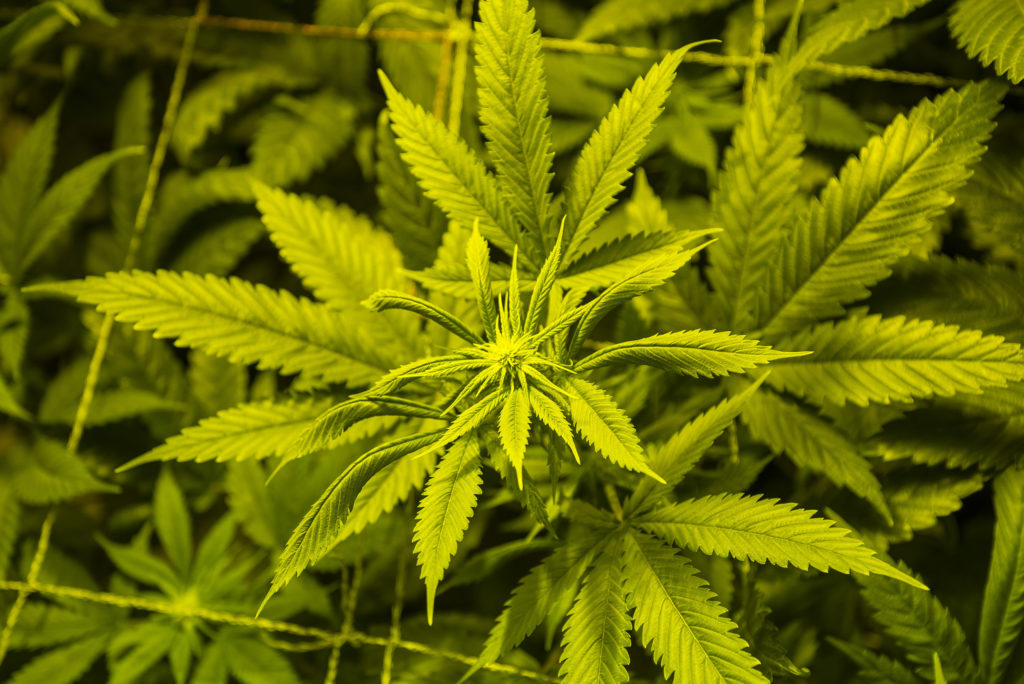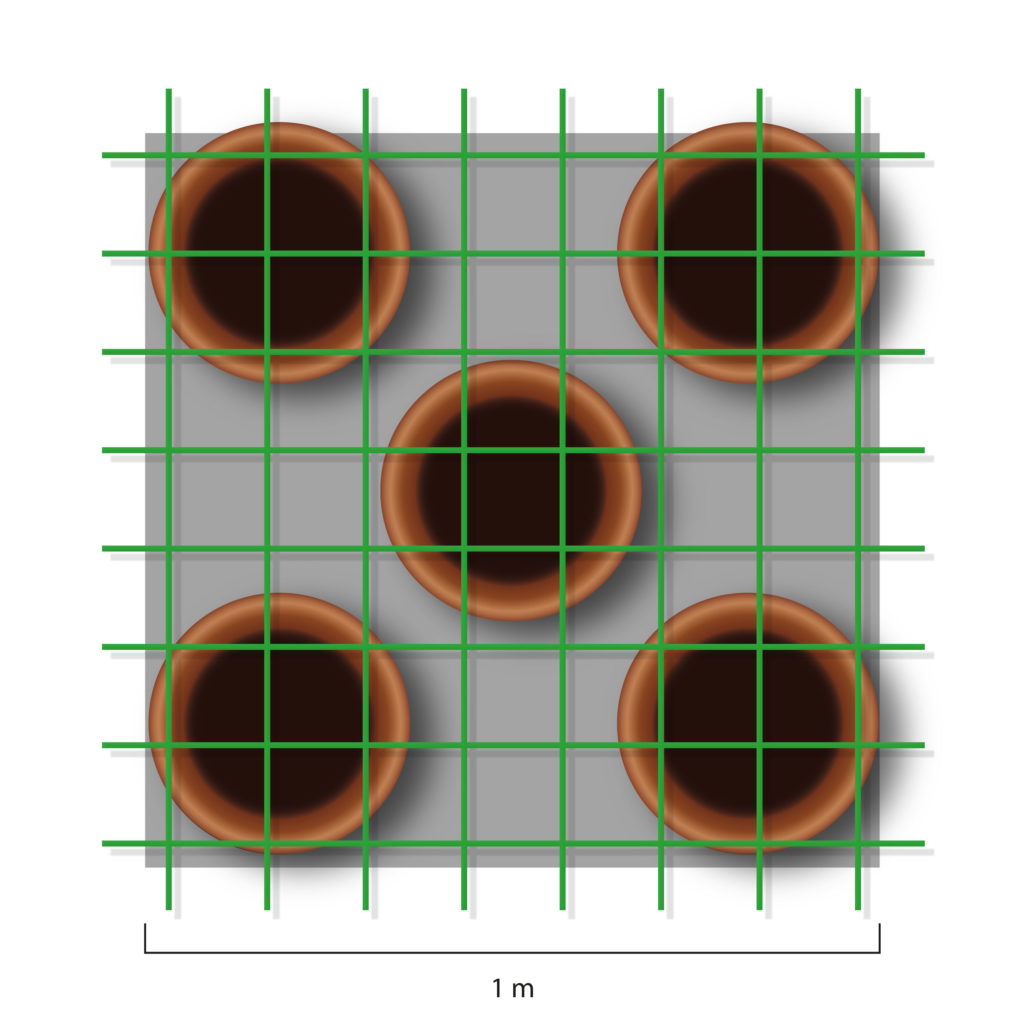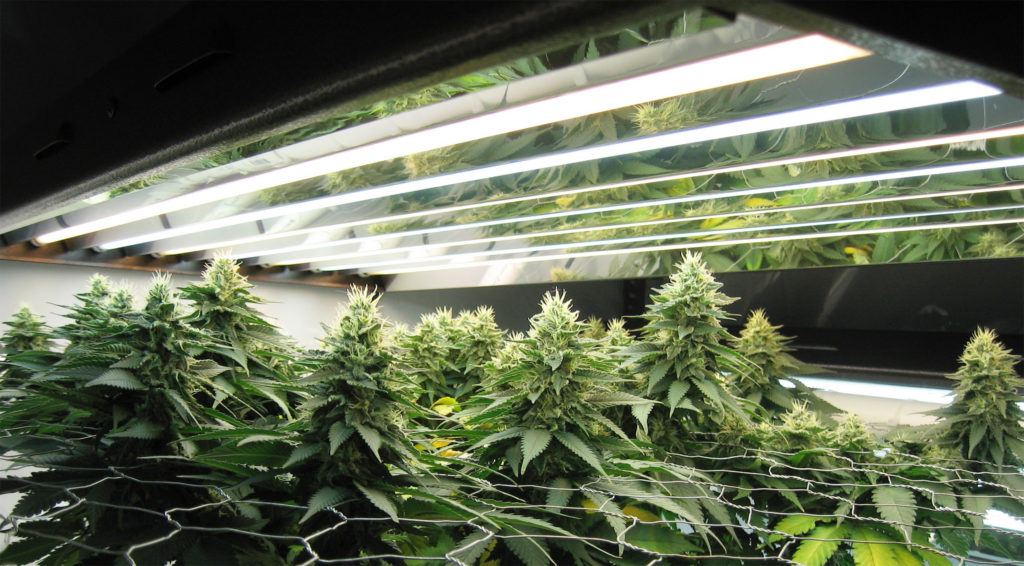Even where cannabis is legal, in many places you are only allowed to have a limited number of plants. Those who want to maximise their yield in the face of this restriction would do best with a Screen of Green. A simple piece of netting will stimulate sideways growth and bud formation. The result: plenty of fat, highly potent buds.
Screen of Green (SCROG) is the name of one of the most efficient and productive methods of growing cannabis. It is suitable for both small home growers and professional cultivators. Basically it is a question of making maximum use of the growing area to obtain the greatest possible yield.
A mesh ensures that the cannabis plants can grow sideways in a controlled manner and with even lighting. This leads to the formation of plenty of buds. In the ideal case you will end up with a thick, even carpet of buds.
This article explains how this approach works in detail, and what you need to bear in mind.
1. The right type of plants
Before starting with the construction itself, you need to select the right types of plant. Because the growth phase lasts longer using the Screen of Green method than with other methods of cultivation, auto-flowering cannabis plants are not suitable.
Whether you start from seeds or seedlings is a matter of personal preference. Many growers prefer seedlings because they grow homogenously and their growth structure is predictable, but seeds also work perfectly well with a Screen of Green. You need to ensure that the plants grow evenly and will flower at about the same time.
Ideally, you should use either Indica, or Sativa varieties. A combination is not recommended. If you decide to go with a Sativa variety, then the pruning will involve more work, but the SCROG method is perfect for managing a cannabis variety that typically tries to shoot up.
The following varieties are particularly suitable for a Screen of Green: Michka, Silver Haze, Skunk #1, Super Skunk and Afghani #1.
2. Ideal growing conditions
It is important that the plants have enough space. In contrast to the Sea of Green approach, the pots should not be too close together. Around 30 x 30 cm per plant, or 1 to 5 plants per square metre, has proved successful. Getting a big harvest from just a few plants is one of the main benefits of the SCROG approach!
After planting in the pots, a mesh is installed between the plants and the lights. The plants will grow up to this height. Some growers construct their own netting from (hemp) ropes, washing lines, bamboo or fine wire. It is simpler to work with ready-made manufactured mesh. This comes in various shapes and sizes and is usually made of plastic, metal or nylon.
The height of the netting will be higher or lower, depending on the variety of cannabis being grown. Around 20 cm above the top of the pot is the right height for Indica varieties, for Sativa the best height is around 45 cm, and for Haze or Thai varieties the height should be as much as 60 cm above the top of the pot.
After each harvest, the net needs to be thoroughly washed or replaced.
3. The growth phase
With the SCROG approach, the focus is on the plants growing sideways. Depending on the variety of marijuana, the growth phase lasts three to eight weeks. Fast-growing Sativa varieties will reach the net sooner than Indica varieties.
Once the plants are about 25 cm high, you need to take action. The tips of the main growing points need to be pinched out. This is how you force the plants to spread sideways.
All the shoots that appear above the net need to be fixed into the mesh structure. In most cases you can simply weave them into place. Push the shoots carefully under the next hole to create a thick, even plant carpet.
It is important to avoid breaking off any side-shoots or branches, because the plant will then waste energy sending up new shoots. Very thick shoots that stretch a long way may need to be tied to the netting. The best way is to use plant ties.
The lower branches are pruned to ensure that the plants put all their energy into the upper branches, where the buds will later appear.
4. The flowering phase
Once you are happy with the horizontal growth, you can trigger the flowering phase. This is done by reducing the lighting from 18 hours to 12 hours. Growers have to decide for themselves exactly when this should take place. Generally speaking, with a Screen of Green the vegetation growth should not be pushed to the maximum, as the plant will exhaust itself producing new branches instead of forming buds.
The plant is now allowed to grow up through the netting. In order for the buds to receive the maximum amount of light, as many leaves as possible should be pushed back below the netting. If there is strong leaf growth, it is worth cutting off half the leaves. The remaining half will still provide enough energy for the plants and will keep out less light.
From approximately the second week of flowering, the buds will start to grow vertically. A thick carpet of buds will gradually develop. As the canopy becomes increasingly dense, the lower parts of the plants receive less and less light. The leaves will begin to turn yellow. At this time, it is better to cut away all the leaves, branches and buds that are below the netting.
This will ensure that the plants put all their energy into the top buds, and it also improves air circulation. This is important, as large buds in particular have a tendency to attract mould.
As with as any other intervention on growing plants, such as fertilising, great care is needed when pruning or cutting away plant material. It is better to proceed gradually. Do not remove all the branches and leaves at one time, as this may cause the plants to go into shock and stop growing normally or become sickly.
Once you master the SCROG approach, you will be rewarded with a rich harvest. Screen of Green yields can be as much as 20% higher than other forms of cultivation. Of course, some practice is necessary; there is no such thing as an instant expert.
Quick summary of the pros and cons of Screen of Green:
+ one of the most efficient and productive cultivation methods
+ up to 20% higher yields
+ high quality (only 1A buds harvested)
+ the plants do not grow too high
+ particularly well-suited for Sativa and Haze varieties
+ you only need a few plants
– Indica and Sativa varieties cannot easily be combined
– does not work with auto-flowering varieties
– the vegetation phase lasts 1 to 3 weeks longer than with the Sea of Green approach
– a netting mesh needs to be installed
- Disclaimer:Laws and regulations regarding cannabis cultivation differ from country to country. Sensi Seeds therefore strongly advises you to check your local laws and regulations. Do not act in conflict with the law.













Don’t be scared to top or FIM plants. I just finished my 1st grow in a 3′ x 3′ indoor tent. I was extremely nervous to top, but it is important so that the plant does bush more and stretch wider. Bending is an old method that is employed by a ScrOG net. Bending the branches under the ScrOG net does a few things. First, your plant is spread wider; so, all the growth far down on the branches that receives less and less light on a small traditional indoor grow – since you have to raise your lights and since higher growth shades lower growth – is now exposed to light and more fully develops, giving you a higher bud count and increasing your yield. Also, bending the branches redistrubutes plant hormones that encourage lateral growth and nutrient uptake. I just finished up my first grow on a 50/50 hybrid with an avg dry yield of 8 ozs. I topped and used a ScrOG net. My dry yield was 11.5 ozs. It seems counter-intuitive to trim branches, leaves, and buds, but it is absolutely necessary when using the ScrOG net to fully reap the rewards of this method.
I have a friend who’s a commercial grower in California, he grows in 5 gallon fabric pots and fits 16-18 pots per 4’x8′ tray and vegs for 8 weeks. How is this possible to veg that long without over crowding? He won’t give his secrets, he said he usually tops 1-3 times. He also starts with clones. I tried with 3gal pots and by week 7 plants where massive and wild, I grow on 3×6 tables so I figured thays about 8-10 3 gal pots. Every cola he produces is uniform in size and is a top. He usually uses 2 sometimes 3 layers of trellis. How would I replicate this on a smaller level. Even tho he vegs 8 weeks he only averages 4-5oz per plant. The tutorials I find on ScrOG don’t pack as many plants in any area this small. But no matter if it’s a bottom or top they all look the same. Please help.
Good afternoon Matthew,
Unfortunately, legal restrictions mean we can’t answer grow-related questions or give grow advice on this blog. However, other readers of this blog will often answer questions like yours.
This article on Top 6 Cannabis Plant Training Techniques may be of interest to you.
Thanks again. Enjoy the blog!
With best wishes,
Mark
Hi I’m a novice grower and like you was a bit apprehensive about Topping and FIMing but after seeing the results combined with LST plant manipulation I use these techniques every grow.
Now to build a SCRoG net !
Hi, im wondering how much surface of net it is needed for every liter of soil growing it outdoors, i dont want to fall short just before flowering. Thanks
Hi there,
Unfortunately, legal restrictions mean we can’t answer grow-related questions or give grow advice on this blog.
However, other readers of this blog will often answer questions like yours. Sorry I can’t be of more help, and I hope you continue to enjoy the blog!
With best wishes,
Scarlet
I would like to now about transplants to different size pot, in the scrog method. Thanks
Hi there,
Unfortunately, legal restrictions mean we can’t answer grow-related questions or give grow advice on this blog. However, other readers of this blog will often answer questions like yours. Sorry I can’t be of more help, and I hope you continue to enjoy the blog!
With best wishes,
Scarlet
this is actually a traditional way of growing sativas outdoors here in Greece.
people that grew in their gardens, would take advantage of the trellis almost all houses had for their edible grapes in the gardens(providing not only fruit but also shadow in summer).
the very tall landrace sativas (can grow between 4-6 meters tall in most cases), had no problem to stretch to the trellis height and from then on the grower will spread the branches just like in any scrog apparatus.
the very impressive visual effect was taking place just before harvest time, since the heavy buds many times were hanging like grapes above people’s heads… nice childhood memories at my mum’s village (nobody was allowing me to touch though until I was well in my teens, basically 18 and over).
of course the result is more impressive outdoors, but indoors you can get close to that as well. it is the most productive method.
actually I do use it a lot both outdoors and indoors, with much success, whenever I grow autoflowers (I do choose branching varieties). it gives you the chance to tame the wild ruderalis genes to your benefit. with no stress to the plants, you compel them to produce more bud and thc, since they get the maximum equal share of light.
scrog outdoors (or indoors at a place with lots of space) offers the best option to provide a healthy flow of air around the plants. I have my reservations about such a possibility in the cramped space of a growtent, despite the use of fans that can help in this matter.
Thanks so much for sharing this slice of your home-life with us! It’s beautifull to hear!
Hi Im still not sure about topping my plants. I want to scrog next time but topping makes me apprehensive. My plants do grow very tall will topping and a scrog help the plants not grow so tall. I have to alter my lights when they get too tall to get a few more inches of height space. Any info will be a great help thanks??✊?
Paul,
So why not just pinch squeeze, your tall tops and bend/tie them over…
You can train plants to grow in many ways, that you want…
Dr.Chas-THC